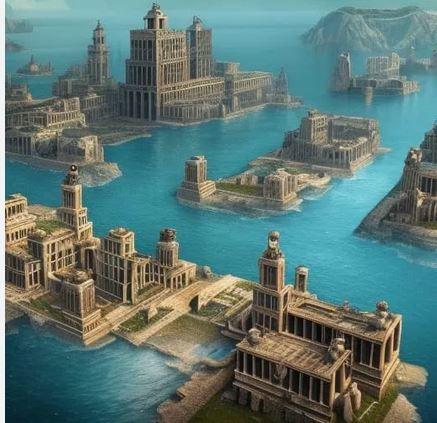Poseidia

🌊 Who Was Edgar Cayce?
-
Known as the “Sleeping Prophet”, Edgar Cayce (1877–1945) gave thousands of readings while in a trance-like state.
-
Topics included health, past lives, reincarnation, and ancient lost civilizations—especially Atlantis.
-
He described Atlantis in rich detail, far beyond what Plato wrote.
🏙️ What Is Poseidia?
According to Cayce, Poseidia was one of the major cities or regions of Atlantis, specifically the most spiritually and technologically advanced.
🌍 Location (according to the readings):
-
A large island region in the western Atlantic Ocean, stretching between what is now Bimini (Bahamas), parts of the Caribbean, and maybe even parts of Florida.
-
Poseidia was located in the southern portion of Atlantis.
-
Cayce even claimed that remains of Poseidia would rise again, and predicted:
“Poseidia will be among the first portions of Atlantis to rise again. Expect it in ‘68 and ‘69.” (Reading 958-3)
While the physical rising didn’t happen, some link this to underwater discoveries like the Bimini Road.
🧬 Characteristics of Poseidia (from Cayce’s Readings)
✨ 1. Spiritual-Scientific Culture
-
Poseidia was a society where spiritual knowledge and advanced science were blended harmoniously.
-
Citizens were said to work with crystal energy, telepathy, levitation, and even anti-gravity devices.
🔋 2. The Great Crystal (Tuaoi Stone or Firestone)
-
Central to Poseidia was a massive crystal tower, called the Tuaoi Stone.
-
It was used to draw power from the sun, stars, and the Earth's magnetic fields.
-
Powered everything from transportation to healing and communication.
-
When misused, this crystal may have caused catastrophic destruction, contributing to the fall of Atlantis.
🧬 3. Atlantean Technology
-
Flying vehicles, underground tunnels, and even interplanetary contact were hinted at in Cayce’s descriptions.
-
He spoke of genetic manipulation, including the creation of hybrids, sometimes called the “things” or the beast-men—early artificial beings.
🧠 4. Sons of the Law of One vs. Sons of Belial
-
Atlantis, including Poseidia, had two major factions:
-
Sons of the Law of One: Spiritually enlightened, believed in unity, reincarnation, and service to others.
-
Sons of Belial: Materialistic, self-serving, and exploitative. Focused on power and domination.
-
-
Poseidia was home to the Law of One, and its culture embodied harmony, balance, and consciousness.
-
The tension between these groups led to warfare, misuse of tech, and eventually, destruction
🌪️ The Fall of Poseidia
-
According to Cayce, Poseidia survived the first Atlantean destruction, around 50,000 B.C., and even the second, around 28,000 B.C.
-
It was only during the final destruction, around 10,000–12,000 B.C., that Poseidia was submerged entirely.
-
Cayce suggested that Atlantean souls reincarnated throughout time—especially in modern America, often with karmic ties to their past lives in Poseidia.
🧘 Why Poseidia Matters (Spiritually)
Poseidia in Cayce’s work isn’t just a mythic city—it’s a symbol of a spiritually advanced human state that was lost due to ego, imbalance, and misuse of power.
-
It echoes the Fall of Man, the loss of Eden, or the Tower of Babel—a once-golden civilization corrupted by pride.
-
Its memory is thought to live within the collective unconscious, and Cayce believed that rediscovering Poseidia (physically or spiritually) would be part of humanity’s awakening and return to higher consciousness.
🗺️ Modern Links
-
Bimini Road (Bahamas): Believed by some to be part of Poseidia's ruins—discovered in 1968, the same year Cayce "predicted" something would rise.
-
Crystal healing, Atlantean energy work, and Law of One philosophies often draw from Cayce’s Poseidia narrative.

